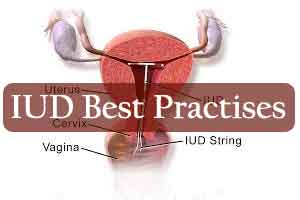- Home
- Editorial
- News
- Practice Guidelines
- Anesthesiology Guidelines
- Cancer Guidelines
- Cardiac Sciences Guidelines
- Critical Care Guidelines
- Dentistry Guidelines
- Dermatology Guidelines
- Diabetes and Endo Guidelines
- Diagnostics Guidelines
- ENT Guidelines
- Featured Practice Guidelines
- Gastroenterology Guidelines
- Geriatrics Guidelines
- Medicine Guidelines
- Nephrology Guidelines
- Neurosciences Guidelines
- Obs and Gynae Guidelines
- Ophthalmology Guidelines
- Orthopaedics Guidelines
- Paediatrics Guidelines
- Psychiatry Guidelines
- Pulmonology Guidelines
- Radiology Guidelines
- Surgery Guidelines
- Urology Guidelines
Guidelines to minimise infection risk with intrauterine device insertion

The most serious complication associated with IUDs is infection. Early analyses suggested that IUDs might cause pelvic inflammatory disease (PID). .Infections that are truly related to the IUD are a result of insertion; in other words, contamination of the uterine cavity with organisms from the vaginal flora occurs at the time the IUD is inserted. Still, this risk is minimal (0.97%) and is limited to the first 20 days after insertion.Antibiotic prophylaxis with doxycycline, 200mg administered orally 1 hour prior to insertion, has been evaluated and shown to be of no benefit .
In 2014,Caddy S, Yudin MH, Hakim J, Money DM, Infectious Disease Committee, Society of Obstetricians and Gynaecologists of Canada published, ' Best practices on how to minimize risk of infection with intrauterine device insertion.' The major recommendations of the best practises can be summarised as follows:-
Risk of Pelvic Inflammatory Disease (PID) After Insertion
Recommendation
- All women requesting an intrauterine device (IUD) should be counselled about the small increased risk of PID in the first 20 days after insertion.
Role of and Indications for Screening for Sexually Transmitted Infections (STIs)
Recommendation
- All women requesting an IUD should be screened by both history and physical examination for their risk of STI. Women at increased risk should be tested prior to or at the time of insertion; however, it is not necessary to delay insertion until results are returned.
Bacterial Vaginosis
Recommendation
- Not enough current evidence is available to support routine screening for bacterial vaginosis at the time of insertion of an IUD in asymptomatic women.
Role of Prophylactic Antibiotics
Recommendation
- Routine use of prophylactic antibiotics is not recommended prior to IUD insertion, although it may be used in certain high-risk situations.
Insertion Technique
Recommendation
- Standard practice includes cleansing the cervix and sterilizing any instruments that will be used prior to and during insertion of an IUD.
Management of PID with IUD In Situ
Recommendation
- In treating mild to moderate PID, it is not necessary to remove the IUD during treatment unless the patient requests removal or there is no clinical improvement after 72 hours of appropriate antibiotic treatment. In cases of severe PID, consideration can be given to removing the IUD after an appropriate antibiotic regimen has been started.
Special Populations
Human Immunodeficiency Virus (HIV)-Positive Women
Recommendation
- An IUD is a safe, effective option for contraception in an HIV-positive woman.
Adolescents
Recommendation
- An IUD can be considered a first-line contraceptive agent in adolescents.
To read further click on the following link: http://www.ncbi.nlm.nih.gov/pubmed/24612897?dopt=Abstract
Best practices on how to minimize risk of infection with intrauterine device insertioninfection with IUDintrauterine device infectionIUDSociety of Obstetricians and Gynaecologists of Canada
Source : Society of Obstetricians and Gynaecologists of CanadaNext Story
NO DATA FOUND

Disclaimer: This site is primarily intended for healthcare professionals. Any content/information on this website does not replace the advice of medical and/or health professionals and should not be construed as medical/diagnostic advice/endorsement or prescription. Use of this site is subject to our terms of use, privacy policy, advertisement policy. © 2020 Minerva Medical Treatment Pvt Ltd